Comprehensive Examination of Fiduciary Duties within Equity and Trusts
VerifiedAdded on 2022/10/16
|8
|2636
|154
Essay
AI Summary
This essay provides a comprehensive overview of fiduciary duties within the context of equity and trusts. It begins by defining fiduciary duties and their origins in Roman law, emphasizing the importance of loyalty and the avoidance of conflicts of interest. The essay explores the background of fiduciary relationships, including examples like trustees, agents, and company directors, highlighting the significance of the Bristol and West Building Society v Mothew case. It then delves into the concept of trusts, differentiating between legal and beneficial interests, and outlining the various types of trusts. The core of the essay focuses on the specific duties of trustees, including the duty of care, duty of loyalty (with components like non-misrepresentation, non-self-dealing, and confidentiality), duty to administer the trust according to its terms, duty to secure and safeguard trust property, duty to segregate and identify assets, and the duty to account and invest prudently. The essay references key case laws such as Keech v Sandford and Shriners’ Hospitals for Crippled Children v. Gardiner, illustrating the practical application of these duties. The essay concludes by emphasizing the importance of these duties in upholding the integrity of trust relationships and protecting the interests of beneficiaries. Students can find this and other helpful resources on Desklib.

EQUITY AND TRUSTS
Paraphrase This Document
Need a fresh take? Get an instant paraphrase of this document with our AI Paraphraser
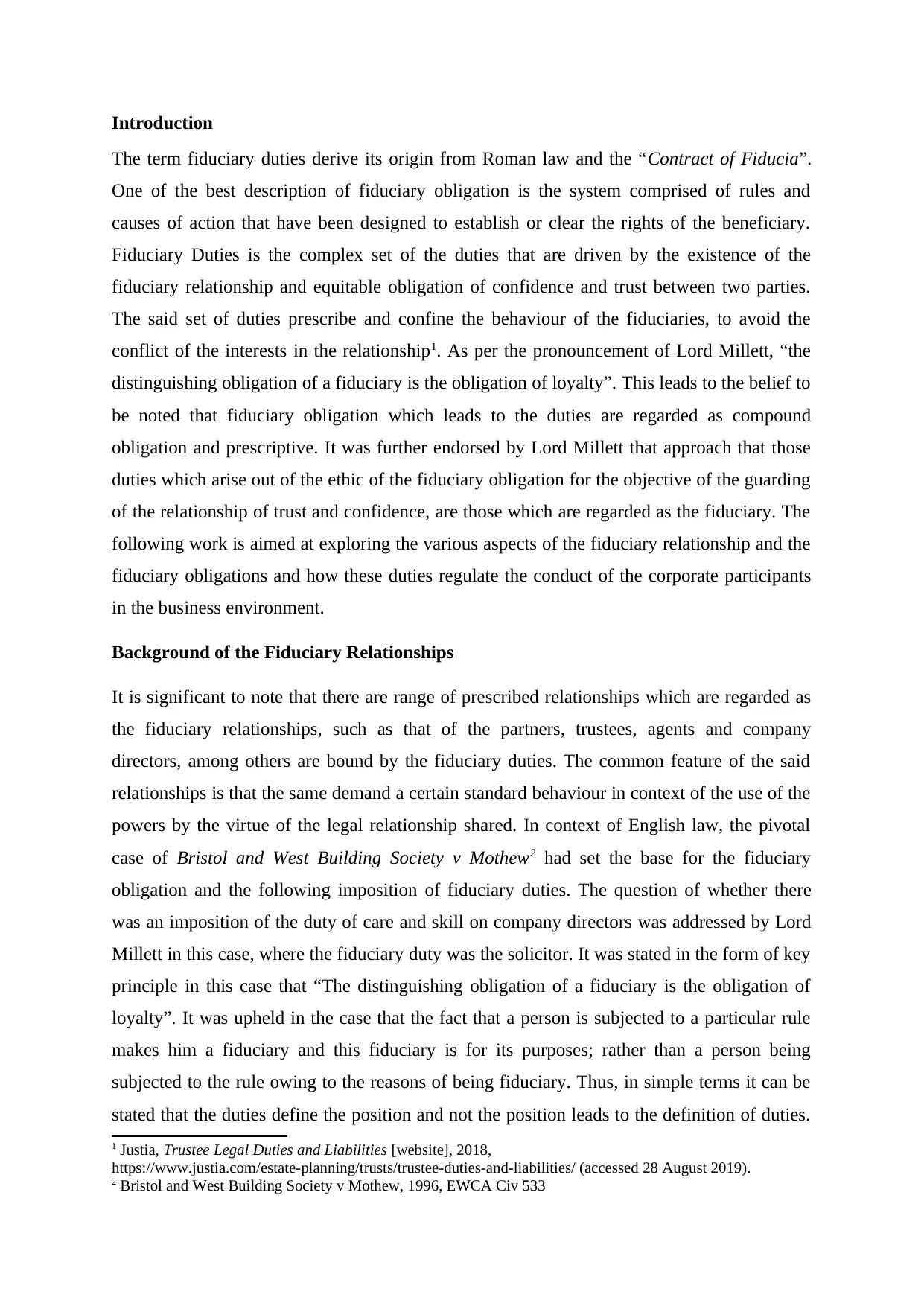
Introduction
The term fiduciary duties derive its origin from Roman law and the “Contract of Fiducia”.
One of the best description of fiduciary obligation is the system comprised of rules and
causes of action that have been designed to establish or clear the rights of the beneficiary.
Fiduciary Duties is the complex set of the duties that are driven by the existence of the
fiduciary relationship and equitable obligation of confidence and trust between two parties.
The said set of duties prescribe and confine the behaviour of the fiduciaries, to avoid the
conflict of the interests in the relationship1. As per the pronouncement of Lord Millett, “the
distinguishing obligation of a fiduciary is the obligation of loyalty”. This leads to the belief to
be noted that fiduciary obligation which leads to the duties are regarded as compound
obligation and prescriptive. It was further endorsed by Lord Millett that approach that those
duties which arise out of the ethic of the fiduciary obligation for the objective of the guarding
of the relationship of trust and confidence, are those which are regarded as the fiduciary. The
following work is aimed at exploring the various aspects of the fiduciary relationship and the
fiduciary obligations and how these duties regulate the conduct of the corporate participants
in the business environment.
Background of the Fiduciary Relationships
It is significant to note that there are range of prescribed relationships which are regarded as
the fiduciary relationships, such as that of the partners, trustees, agents and company
directors, among others are bound by the fiduciary duties. The common feature of the said
relationships is that the same demand a certain standard behaviour in context of the use of the
powers by the virtue of the legal relationship shared. In context of English law, the pivotal
case of Bristol and West Building Society v Mothew2 had set the base for the fiduciary
obligation and the following imposition of fiduciary duties. The question of whether there
was an imposition of the duty of care and skill on company directors was addressed by Lord
Millett in this case, where the fiduciary duty was the solicitor. It was stated in the form of key
principle in this case that “The distinguishing obligation of a fiduciary is the obligation of
loyalty”. It was upheld in the case that the fact that a person is subjected to a particular rule
makes him a fiduciary and this fiduciary is for its purposes; rather than a person being
subjected to the rule owing to the reasons of being fiduciary. Thus, in simple terms it can be
stated that the duties define the position and not the position leads to the definition of duties.
1 Justia, Trustee Legal Duties and Liabilities [website], 2018,
https://www.justia.com/estate-planning/trusts/trustee-duties-and-liabilities/ (accessed 28 August 2019).
2 Bristol and West Building Society v Mothew, 1996, EWCA Civ 533
The term fiduciary duties derive its origin from Roman law and the “Contract of Fiducia”.
One of the best description of fiduciary obligation is the system comprised of rules and
causes of action that have been designed to establish or clear the rights of the beneficiary.
Fiduciary Duties is the complex set of the duties that are driven by the existence of the
fiduciary relationship and equitable obligation of confidence and trust between two parties.
The said set of duties prescribe and confine the behaviour of the fiduciaries, to avoid the
conflict of the interests in the relationship1. As per the pronouncement of Lord Millett, “the
distinguishing obligation of a fiduciary is the obligation of loyalty”. This leads to the belief to
be noted that fiduciary obligation which leads to the duties are regarded as compound
obligation and prescriptive. It was further endorsed by Lord Millett that approach that those
duties which arise out of the ethic of the fiduciary obligation for the objective of the guarding
of the relationship of trust and confidence, are those which are regarded as the fiduciary. The
following work is aimed at exploring the various aspects of the fiduciary relationship and the
fiduciary obligations and how these duties regulate the conduct of the corporate participants
in the business environment.
Background of the Fiduciary Relationships
It is significant to note that there are range of prescribed relationships which are regarded as
the fiduciary relationships, such as that of the partners, trustees, agents and company
directors, among others are bound by the fiduciary duties. The common feature of the said
relationships is that the same demand a certain standard behaviour in context of the use of the
powers by the virtue of the legal relationship shared. In context of English law, the pivotal
case of Bristol and West Building Society v Mothew2 had set the base for the fiduciary
obligation and the following imposition of fiduciary duties. The question of whether there
was an imposition of the duty of care and skill on company directors was addressed by Lord
Millett in this case, where the fiduciary duty was the solicitor. It was stated in the form of key
principle in this case that “The distinguishing obligation of a fiduciary is the obligation of
loyalty”. It was upheld in the case that the fact that a person is subjected to a particular rule
makes him a fiduciary and this fiduciary is for its purposes; rather than a person being
subjected to the rule owing to the reasons of being fiduciary. Thus, in simple terms it can be
stated that the duties define the position and not the position leads to the definition of duties.
1 Justia, Trustee Legal Duties and Liabilities [website], 2018,
https://www.justia.com/estate-planning/trusts/trustee-duties-and-liabilities/ (accessed 28 August 2019).
2 Bristol and West Building Society v Mothew, 1996, EWCA Civ 533
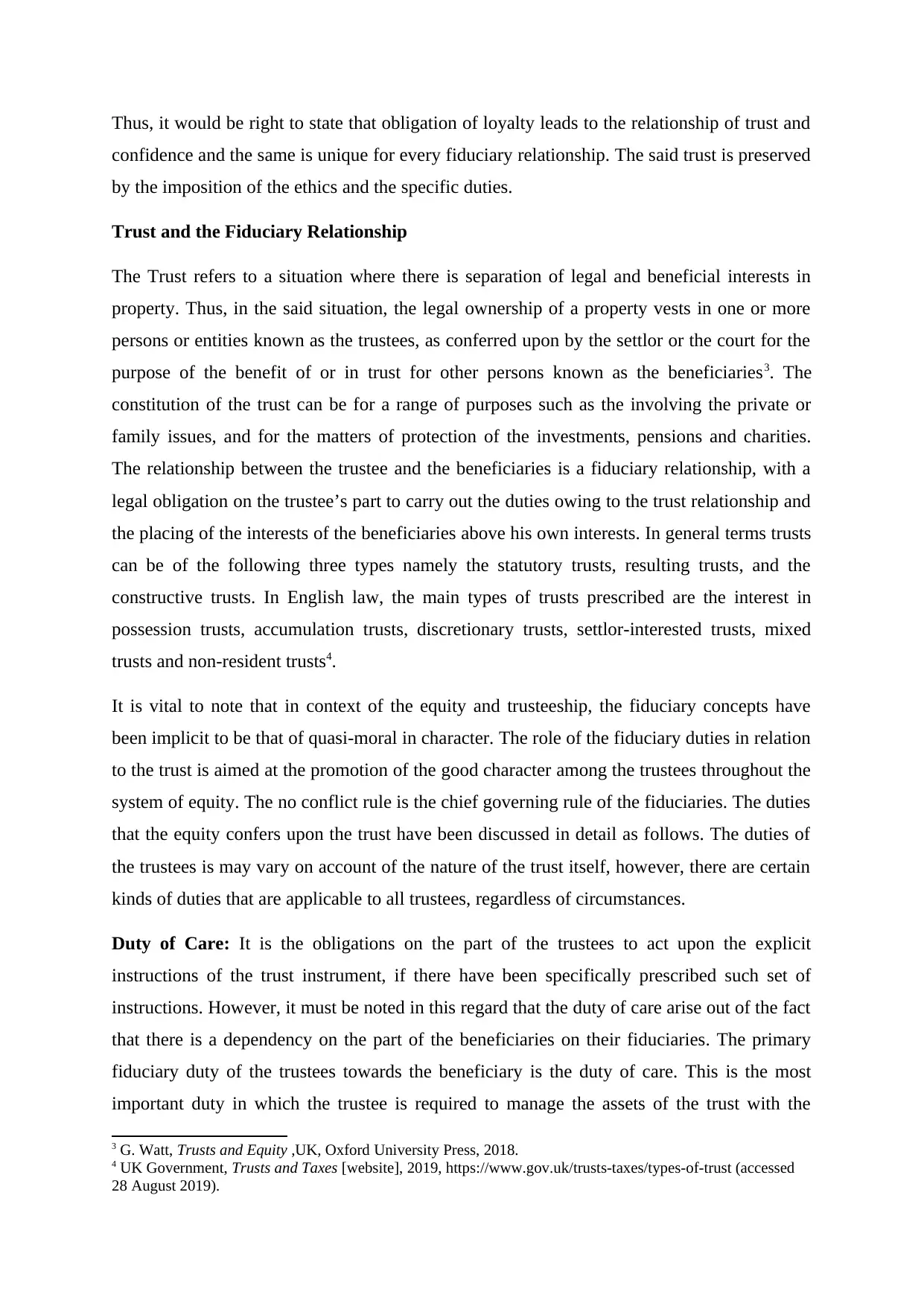
Thus, it would be right to state that obligation of loyalty leads to the relationship of trust and
confidence and the same is unique for every fiduciary relationship. The said trust is preserved
by the imposition of the ethics and the specific duties.
Trust and the Fiduciary Relationship
The Trust refers to a situation where there is separation of legal and beneficial interests in
property. Thus, in the said situation, the legal ownership of a property vests in one or more
persons or entities known as the trustees, as conferred upon by the settlor or the court for the
purpose of the benefit of or in trust for other persons known as the beneficiaries3. The
constitution of the trust can be for a range of purposes such as the involving the private or
family issues, and for the matters of protection of the investments, pensions and charities.
The relationship between the trustee and the beneficiaries is a fiduciary relationship, with a
legal obligation on the trustee’s part to carry out the duties owing to the trust relationship and
the placing of the interests of the beneficiaries above his own interests. In general terms trusts
can be of the following three types namely the statutory trusts, resulting trusts, and the
constructive trusts. In English law, the main types of trusts prescribed are the interest in
possession trusts, accumulation trusts, discretionary trusts, settlor-interested trusts, mixed
trusts and non-resident trusts4.
It is vital to note that in context of the equity and trusteeship, the fiduciary concepts have
been implicit to be that of quasi-moral in character. The role of the fiduciary duties in relation
to the trust is aimed at the promotion of the good character among the trustees throughout the
system of equity. The no conflict rule is the chief governing rule of the fiduciaries. The duties
that the equity confers upon the trust have been discussed in detail as follows. The duties of
the trustees is may vary on account of the nature of the trust itself, however, there are certain
kinds of duties that are applicable to all trustees, regardless of circumstances.
Duty of Care: It is the obligations on the part of the trustees to act upon the explicit
instructions of the trust instrument, if there have been specifically prescribed such set of
instructions. However, it must be noted in this regard that the duty of care arise out of the fact
that there is a dependency on the part of the beneficiaries on their fiduciaries. The primary
fiduciary duty of the trustees towards the beneficiary is the duty of care. This is the most
important duty in which the trustee is required to manage the assets of the trust with the
3 G. Watt, Trusts and Equity ,UK, Oxford University Press, 2018.
4 UK Government, Trusts and Taxes [website], 2019, https://www.gov.uk/trusts-taxes/types-of-trust (accessed
28 August 2019).
confidence and the same is unique for every fiduciary relationship. The said trust is preserved
by the imposition of the ethics and the specific duties.
Trust and the Fiduciary Relationship
The Trust refers to a situation where there is separation of legal and beneficial interests in
property. Thus, in the said situation, the legal ownership of a property vests in one or more
persons or entities known as the trustees, as conferred upon by the settlor or the court for the
purpose of the benefit of or in trust for other persons known as the beneficiaries3. The
constitution of the trust can be for a range of purposes such as the involving the private or
family issues, and for the matters of protection of the investments, pensions and charities.
The relationship between the trustee and the beneficiaries is a fiduciary relationship, with a
legal obligation on the trustee’s part to carry out the duties owing to the trust relationship and
the placing of the interests of the beneficiaries above his own interests. In general terms trusts
can be of the following three types namely the statutory trusts, resulting trusts, and the
constructive trusts. In English law, the main types of trusts prescribed are the interest in
possession trusts, accumulation trusts, discretionary trusts, settlor-interested trusts, mixed
trusts and non-resident trusts4.
It is vital to note that in context of the equity and trusteeship, the fiduciary concepts have
been implicit to be that of quasi-moral in character. The role of the fiduciary duties in relation
to the trust is aimed at the promotion of the good character among the trustees throughout the
system of equity. The no conflict rule is the chief governing rule of the fiduciaries. The duties
that the equity confers upon the trust have been discussed in detail as follows. The duties of
the trustees is may vary on account of the nature of the trust itself, however, there are certain
kinds of duties that are applicable to all trustees, regardless of circumstances.
Duty of Care: It is the obligations on the part of the trustees to act upon the explicit
instructions of the trust instrument, if there have been specifically prescribed such set of
instructions. However, it must be noted in this regard that the duty of care arise out of the fact
that there is a dependency on the part of the beneficiaries on their fiduciaries. The primary
fiduciary duty of the trustees towards the beneficiary is the duty of care. This is the most
important duty in which the trustee is required to manage the assets of the trust with the
3 G. Watt, Trusts and Equity ,UK, Oxford University Press, 2018.
4 UK Government, Trusts and Taxes [website], 2019, https://www.gov.uk/trusts-taxes/types-of-trust (accessed
28 August 2019).
⊘ This is a preview!⊘
Do you want full access?
Subscribe today to unlock all pages.

Trusted by 1+ million students worldwide
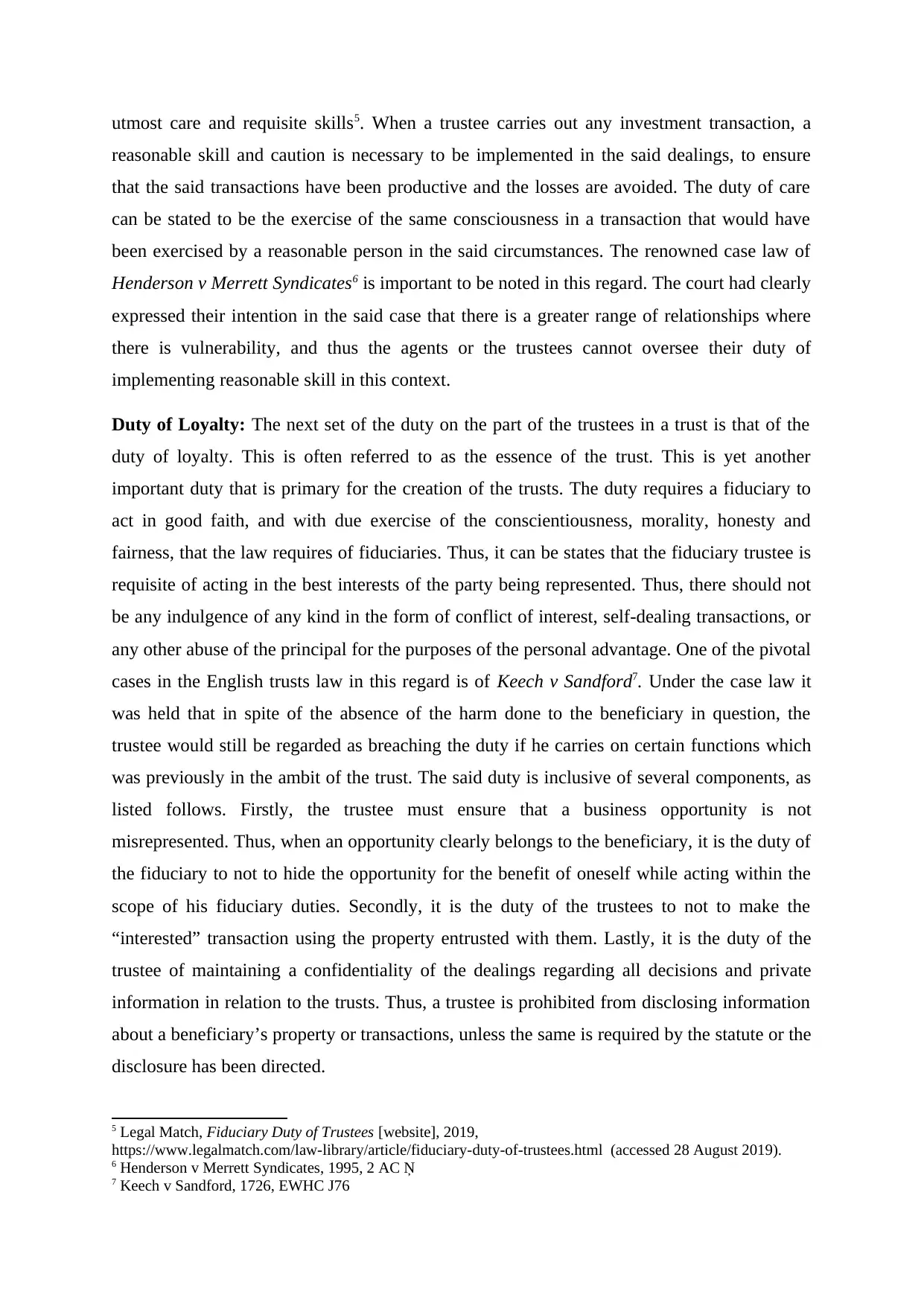
utmost care and requisite skills5. When a trustee carries out any investment transaction, a
reasonable skill and caution is necessary to be implemented in the said dealings, to ensure
that the said transactions have been productive and the losses are avoided. The duty of care
can be stated to be the exercise of the same consciousness in a transaction that would have
been exercised by a reasonable person in the said circumstances. The renowned case law of
Henderson v Merrett Syndicates6 is important to be noted in this regard. The court had clearly
expressed their intention in the said case that there is a greater range of relationships where
there is vulnerability, and thus the agents or the trustees cannot oversee their duty of
implementing reasonable skill in this context.
Duty of Loyalty: The next set of the duty on the part of the trustees in a trust is that of the
duty of loyalty. This is often referred to as the essence of the trust. This is yet another
important duty that is primary for the creation of the trusts. The duty requires a fiduciary to
act in good faith, and with due exercise of the conscientiousness, morality, honesty and
fairness, that the law requires of fiduciaries. Thus, it can be states that the fiduciary trustee is
requisite of acting in the best interests of the party being represented. Thus, there should not
be any indulgence of any kind in the form of conflict of interest, self-dealing transactions, or
any other abuse of the principal for the purposes of the personal advantage. One of the pivotal
cases in the English trusts law in this regard is of Keech v Sandford7. Under the case law it
was held that in spite of the absence of the harm done to the beneficiary in question, the
trustee would still be regarded as breaching the duty if he carries on certain functions which
was previously in the ambit of the trust. The said duty is inclusive of several components, as
listed follows. Firstly, the trustee must ensure that a business opportunity is not
misrepresented. Thus, when an opportunity clearly belongs to the beneficiary, it is the duty of
the fiduciary to not to hide the opportunity for the benefit of oneself while acting within the
scope of his fiduciary duties. Secondly, it is the duty of the trustees to not to make the
“interested” transaction using the property entrusted with them. Lastly, it is the duty of the
trustee of maintaining a confidentiality of the dealings regarding all decisions and private
information in relation to the trusts. Thus, a trustee is prohibited from disclosing information
about a beneficiary’s property or transactions, unless the same is required by the statute or the
disclosure has been directed.
5 Legal Match, Fiduciary Duty of Trustees [website], 2019,
https://www.legalmatch.com/law-library/article/fiduciary-duty-of-trustees.html (accessed 28 August 2019).
6 Henderson v Merrett Syndicates, 1995, 2 AC Ņ
7 Keech v Sandford, 1726, EWHC J76
reasonable skill and caution is necessary to be implemented in the said dealings, to ensure
that the said transactions have been productive and the losses are avoided. The duty of care
can be stated to be the exercise of the same consciousness in a transaction that would have
been exercised by a reasonable person in the said circumstances. The renowned case law of
Henderson v Merrett Syndicates6 is important to be noted in this regard. The court had clearly
expressed their intention in the said case that there is a greater range of relationships where
there is vulnerability, and thus the agents or the trustees cannot oversee their duty of
implementing reasonable skill in this context.
Duty of Loyalty: The next set of the duty on the part of the trustees in a trust is that of the
duty of loyalty. This is often referred to as the essence of the trust. This is yet another
important duty that is primary for the creation of the trusts. The duty requires a fiduciary to
act in good faith, and with due exercise of the conscientiousness, morality, honesty and
fairness, that the law requires of fiduciaries. Thus, it can be states that the fiduciary trustee is
requisite of acting in the best interests of the party being represented. Thus, there should not
be any indulgence of any kind in the form of conflict of interest, self-dealing transactions, or
any other abuse of the principal for the purposes of the personal advantage. One of the pivotal
cases in the English trusts law in this regard is of Keech v Sandford7. Under the case law it
was held that in spite of the absence of the harm done to the beneficiary in question, the
trustee would still be regarded as breaching the duty if he carries on certain functions which
was previously in the ambit of the trust. The said duty is inclusive of several components, as
listed follows. Firstly, the trustee must ensure that a business opportunity is not
misrepresented. Thus, when an opportunity clearly belongs to the beneficiary, it is the duty of
the fiduciary to not to hide the opportunity for the benefit of oneself while acting within the
scope of his fiduciary duties. Secondly, it is the duty of the trustees to not to make the
“interested” transaction using the property entrusted with them. Lastly, it is the duty of the
trustee of maintaining a confidentiality of the dealings regarding all decisions and private
information in relation to the trusts. Thus, a trustee is prohibited from disclosing information
about a beneficiary’s property or transactions, unless the same is required by the statute or the
disclosure has been directed.
5 Legal Match, Fiduciary Duty of Trustees [website], 2019,
https://www.legalmatch.com/law-library/article/fiduciary-duty-of-trustees.html (accessed 28 August 2019).
6 Henderson v Merrett Syndicates, 1995, 2 AC Ņ
7 Keech v Sandford, 1726, EWHC J76
Paraphrase This Document
Need a fresh take? Get an instant paraphrase of this document with our AI Paraphraser
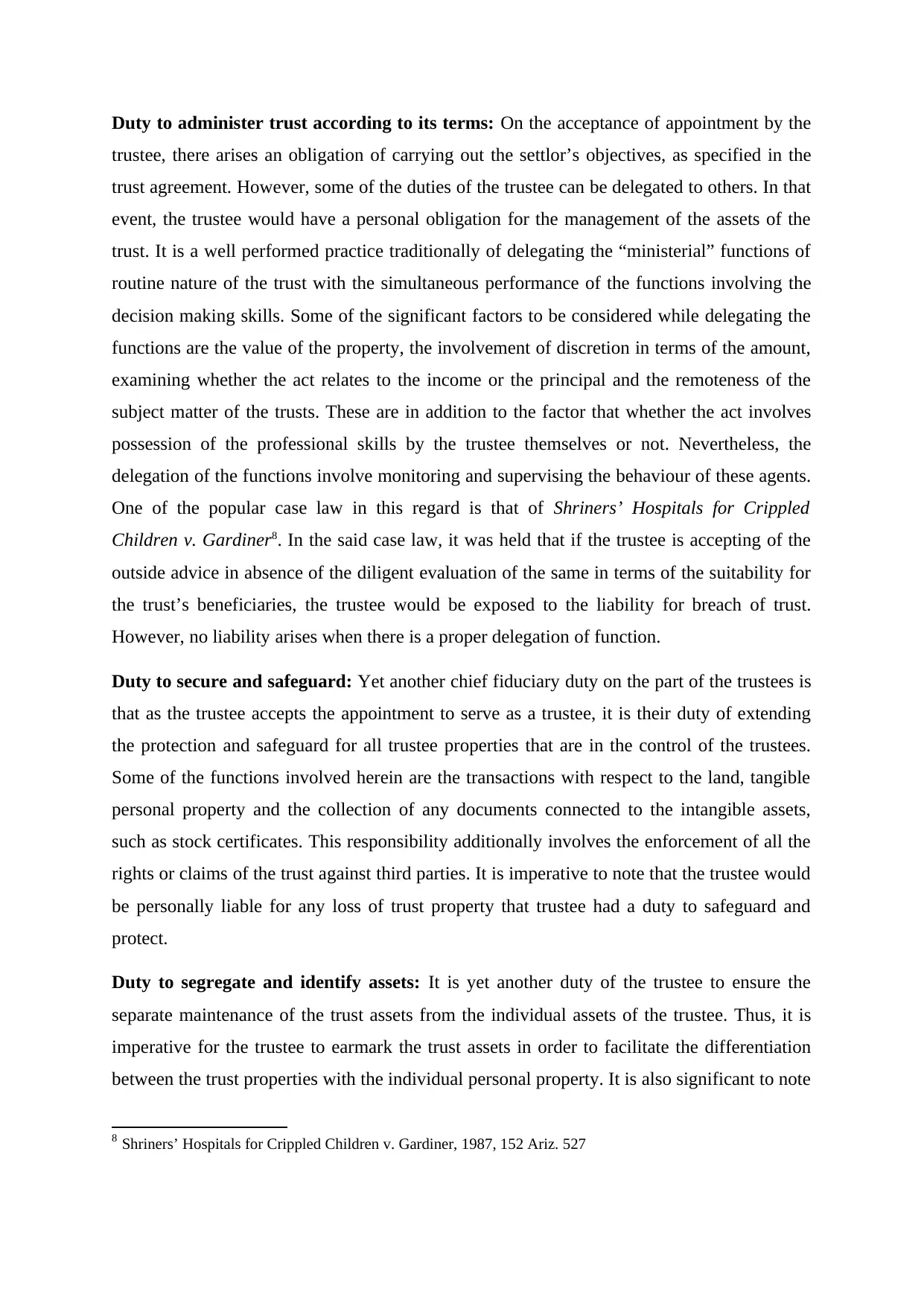
Duty to administer trust according to its terms: On the acceptance of appointment by the
trustee, there arises an obligation of carrying out the settlor’s objectives, as specified in the
trust agreement. However, some of the duties of the trustee can be delegated to others. In that
event, the trustee would have a personal obligation for the management of the assets of the
trust. It is a well performed practice traditionally of delegating the “ministerial” functions of
routine nature of the trust with the simultaneous performance of the functions involving the
decision making skills. Some of the significant factors to be considered while delegating the
functions are the value of the property, the involvement of discretion in terms of the amount,
examining whether the act relates to the income or the principal and the remoteness of the
subject matter of the trusts. These are in addition to the factor that whether the act involves
possession of the professional skills by the trustee themselves or not. Nevertheless, the
delegation of the functions involve monitoring and supervising the behaviour of these agents.
One of the popular case law in this regard is that of Shriners’ Hospitals for Crippled
Children v. Gardiner8. In the said case law, it was held that if the trustee is accepting of the
outside advice in absence of the diligent evaluation of the same in terms of the suitability for
the trust’s beneficiaries, the trustee would be exposed to the liability for breach of trust.
However, no liability arises when there is a proper delegation of function.
Duty to secure and safeguard: Yet another chief fiduciary duty on the part of the trustees is
that as the trustee accepts the appointment to serve as a trustee, it is their duty of extending
the protection and safeguard for all trustee properties that are in the control of the trustees.
Some of the functions involved herein are the transactions with respect to the land, tangible
personal property and the collection of any documents connected to the intangible assets,
such as stock certificates. This responsibility additionally involves the enforcement of all the
rights or claims of the trust against third parties. It is imperative to note that the trustee would
be personally liable for any loss of trust property that trustee had a duty to safeguard and
protect.
Duty to segregate and identify assets: It is yet another duty of the trustee to ensure the
separate maintenance of the trust assets from the individual assets of the trustee. Thus, it is
imperative for the trustee to earmark the trust assets in order to facilitate the differentiation
between the trust properties with the individual personal property. It is also significant to note
8 Shriners’ Hospitals for Crippled Children v. Gardiner, 1987, 152 Ariz. 527
trustee, there arises an obligation of carrying out the settlor’s objectives, as specified in the
trust agreement. However, some of the duties of the trustee can be delegated to others. In that
event, the trustee would have a personal obligation for the management of the assets of the
trust. It is a well performed practice traditionally of delegating the “ministerial” functions of
routine nature of the trust with the simultaneous performance of the functions involving the
decision making skills. Some of the significant factors to be considered while delegating the
functions are the value of the property, the involvement of discretion in terms of the amount,
examining whether the act relates to the income or the principal and the remoteness of the
subject matter of the trusts. These are in addition to the factor that whether the act involves
possession of the professional skills by the trustee themselves or not. Nevertheless, the
delegation of the functions involve monitoring and supervising the behaviour of these agents.
One of the popular case law in this regard is that of Shriners’ Hospitals for Crippled
Children v. Gardiner8. In the said case law, it was held that if the trustee is accepting of the
outside advice in absence of the diligent evaluation of the same in terms of the suitability for
the trust’s beneficiaries, the trustee would be exposed to the liability for breach of trust.
However, no liability arises when there is a proper delegation of function.
Duty to secure and safeguard: Yet another chief fiduciary duty on the part of the trustees is
that as the trustee accepts the appointment to serve as a trustee, it is their duty of extending
the protection and safeguard for all trustee properties that are in the control of the trustees.
Some of the functions involved herein are the transactions with respect to the land, tangible
personal property and the collection of any documents connected to the intangible assets,
such as stock certificates. This responsibility additionally involves the enforcement of all the
rights or claims of the trust against third parties. It is imperative to note that the trustee would
be personally liable for any loss of trust property that trustee had a duty to safeguard and
protect.
Duty to segregate and identify assets: It is yet another duty of the trustee to ensure the
separate maintenance of the trust assets from the individual assets of the trustee. Thus, it is
imperative for the trustee to earmark the trust assets in order to facilitate the differentiation
between the trust properties with the individual personal property. It is also significant to note
8 Shriners’ Hospitals for Crippled Children v. Gardiner, 1987, 152 Ariz. 527
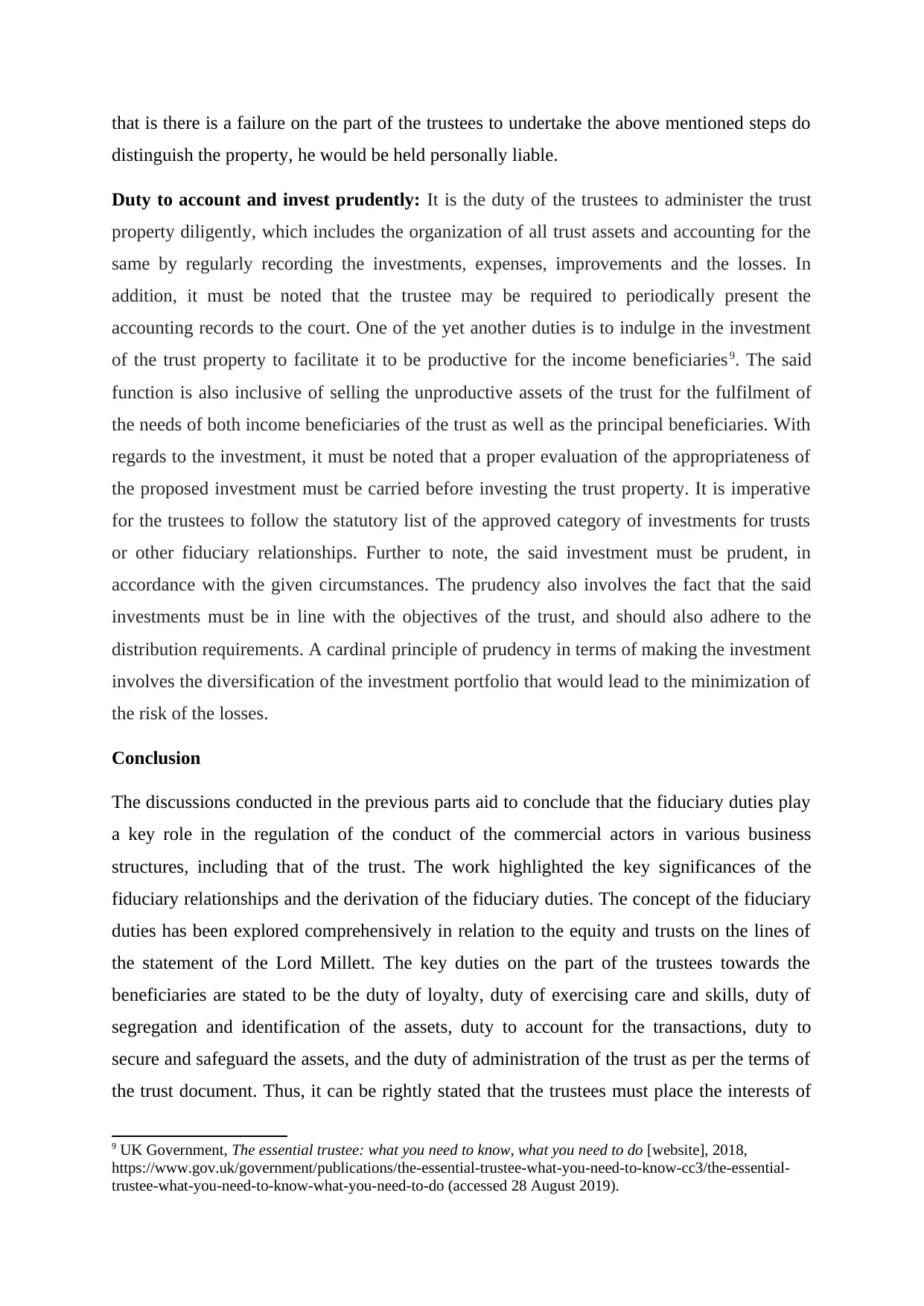
that is there is a failure on the part of the trustees to undertake the above mentioned steps do
distinguish the property, he would be held personally liable.
Duty to account and invest prudently: It is the duty of the trustees to administer the trust
property diligently, which includes the organization of all trust assets and accounting for the
same by regularly recording the investments, expenses, improvements and the losses. In
addition, it must be noted that the trustee may be required to periodically present the
accounting records to the court. One of the yet another duties is to indulge in the investment
of the trust property to facilitate it to be productive for the income beneficiaries9. The said
function is also inclusive of selling the unproductive assets of the trust for the fulfilment of
the needs of both income beneficiaries of the trust as well as the principal beneficiaries. With
regards to the investment, it must be noted that a proper evaluation of the appropriateness of
the proposed investment must be carried before investing the trust property. It is imperative
for the trustees to follow the statutory list of the approved category of investments for trusts
or other fiduciary relationships. Further to note, the said investment must be prudent, in
accordance with the given circumstances. The prudency also involves the fact that the said
investments must be in line with the objectives of the trust, and should also adhere to the
distribution requirements. A cardinal principle of prudency in terms of making the investment
involves the diversification of the investment portfolio that would lead to the minimization of
the risk of the losses.
Conclusion
The discussions conducted in the previous parts aid to conclude that the fiduciary duties play
a key role in the regulation of the conduct of the commercial actors in various business
structures, including that of the trust. The work highlighted the key significances of the
fiduciary relationships and the derivation of the fiduciary duties. The concept of the fiduciary
duties has been explored comprehensively in relation to the equity and trusts on the lines of
the statement of the Lord Millett. The key duties on the part of the trustees towards the
beneficiaries are stated to be the duty of loyalty, duty of exercising care and skills, duty of
segregation and identification of the assets, duty to account for the transactions, duty to
secure and safeguard the assets, and the duty of administration of the trust as per the terms of
the trust document. Thus, it can be rightly stated that the trustees must place the interests of
9 UK Government, The essential trustee: what you need to know, what you need to do [website], 2018,
https://www.gov.uk/government/publications/the-essential-trustee-what-you-need-to-know-cc3/the-essential-
trustee-what-you-need-to-know-what-you-need-to-do (accessed 28 August 2019).
distinguish the property, he would be held personally liable.
Duty to account and invest prudently: It is the duty of the trustees to administer the trust
property diligently, which includes the organization of all trust assets and accounting for the
same by regularly recording the investments, expenses, improvements and the losses. In
addition, it must be noted that the trustee may be required to periodically present the
accounting records to the court. One of the yet another duties is to indulge in the investment
of the trust property to facilitate it to be productive for the income beneficiaries9. The said
function is also inclusive of selling the unproductive assets of the trust for the fulfilment of
the needs of both income beneficiaries of the trust as well as the principal beneficiaries. With
regards to the investment, it must be noted that a proper evaluation of the appropriateness of
the proposed investment must be carried before investing the trust property. It is imperative
for the trustees to follow the statutory list of the approved category of investments for trusts
or other fiduciary relationships. Further to note, the said investment must be prudent, in
accordance with the given circumstances. The prudency also involves the fact that the said
investments must be in line with the objectives of the trust, and should also adhere to the
distribution requirements. A cardinal principle of prudency in terms of making the investment
involves the diversification of the investment portfolio that would lead to the minimization of
the risk of the losses.
Conclusion
The discussions conducted in the previous parts aid to conclude that the fiduciary duties play
a key role in the regulation of the conduct of the commercial actors in various business
structures, including that of the trust. The work highlighted the key significances of the
fiduciary relationships and the derivation of the fiduciary duties. The concept of the fiduciary
duties has been explored comprehensively in relation to the equity and trusts on the lines of
the statement of the Lord Millett. The key duties on the part of the trustees towards the
beneficiaries are stated to be the duty of loyalty, duty of exercising care and skills, duty of
segregation and identification of the assets, duty to account for the transactions, duty to
secure and safeguard the assets, and the duty of administration of the trust as per the terms of
the trust document. Thus, it can be rightly stated that the trustees must place the interests of
9 UK Government, The essential trustee: what you need to know, what you need to do [website], 2018,
https://www.gov.uk/government/publications/the-essential-trustee-what-you-need-to-know-cc3/the-essential-
trustee-what-you-need-to-know-what-you-need-to-do (accessed 28 August 2019).
⊘ This is a preview!⊘
Do you want full access?
Subscribe today to unlock all pages.

Trusted by 1+ million students worldwide
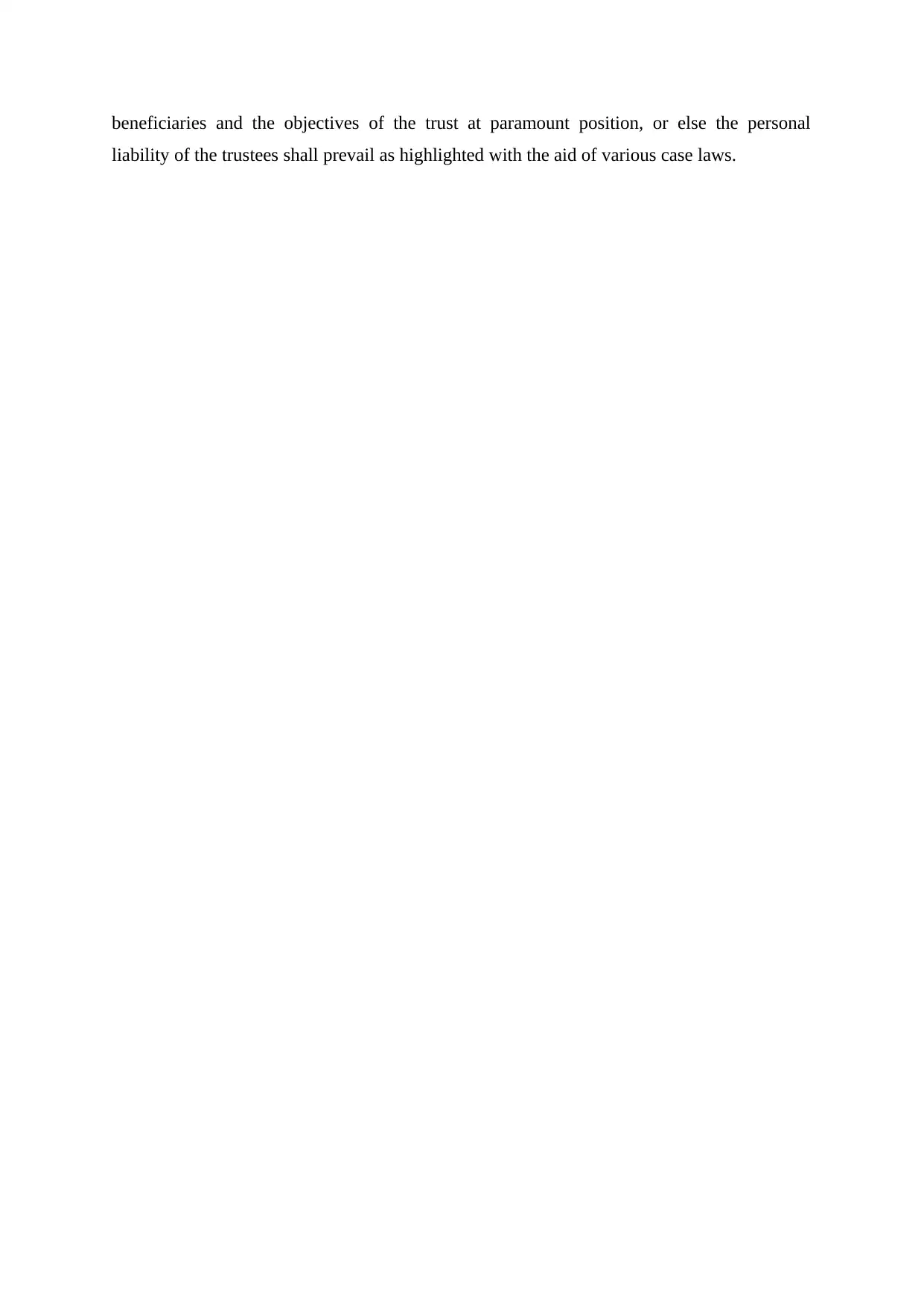
beneficiaries and the objectives of the trust at paramount position, or else the personal
liability of the trustees shall prevail as highlighted with the aid of various case laws.
liability of the trustees shall prevail as highlighted with the aid of various case laws.
Paraphrase This Document
Need a fresh take? Get an instant paraphrase of this document with our AI Paraphraser
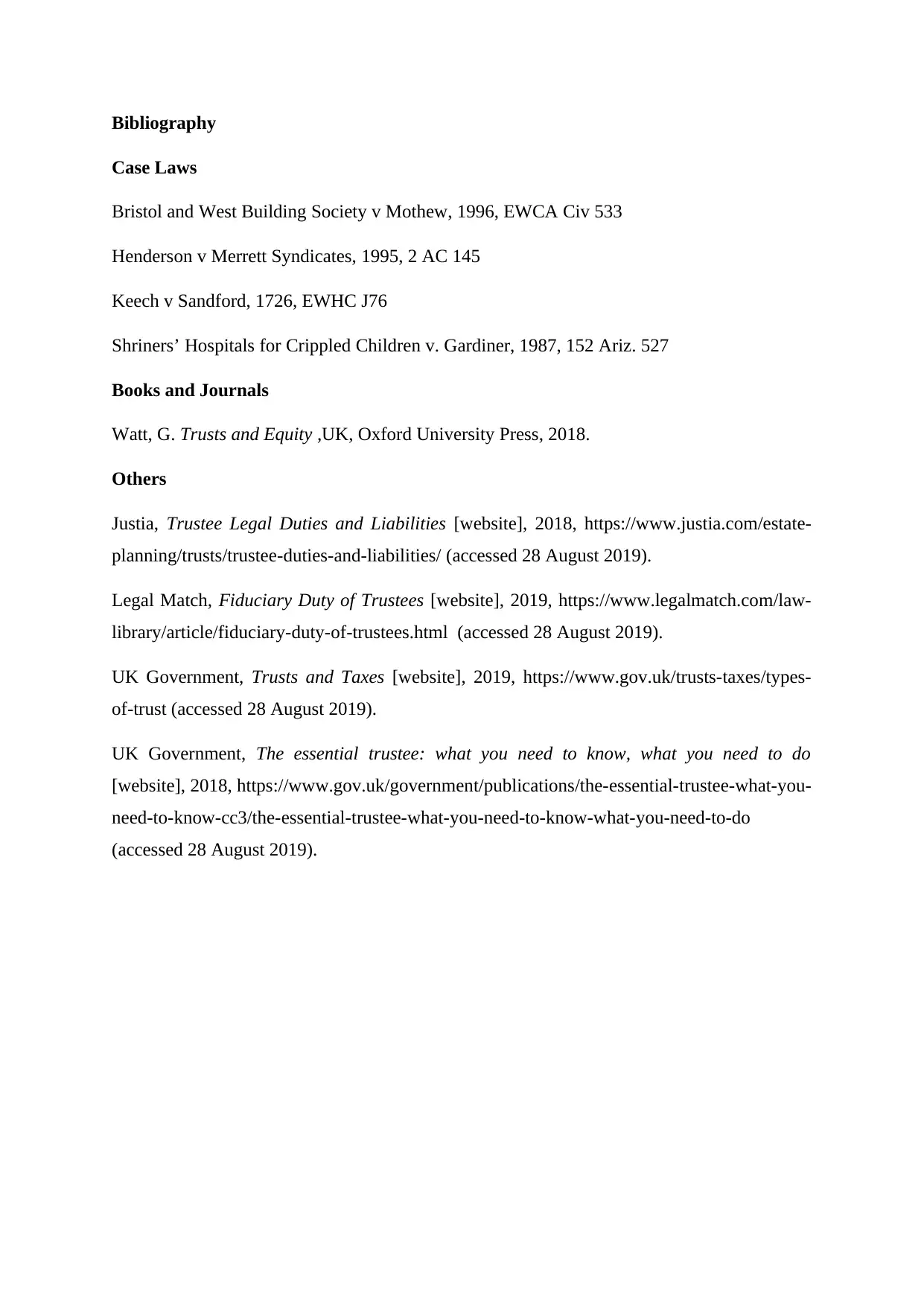
Bibliography
Case Laws
Bristol and West Building Society v Mothew, 1996, EWCA Civ 533
Henderson v Merrett Syndicates, 1995, 2 AC 145
Keech v Sandford, 1726, EWHC J76
Shriners’ Hospitals for Crippled Children v. Gardiner, 1987, 152 Ariz. 527
Books and Journals
Watt, G. Trusts and Equity ,UK, Oxford University Press, 2018.
Others
Justia, Trustee Legal Duties and Liabilities [website], 2018, https://www.justia.com/estate-
planning/trusts/trustee-duties-and-liabilities/ (accessed 28 August 2019).
Legal Match, Fiduciary Duty of Trustees [website], 2019, https://www.legalmatch.com/law-
library/article/fiduciary-duty-of-trustees.html (accessed 28 August 2019).
UK Government, Trusts and Taxes [website], 2019, https://www.gov.uk/trusts-taxes/types-
of-trust (accessed 28 August 2019).
UK Government, The essential trustee: what you need to know, what you need to do
[website], 2018, https://www.gov.uk/government/publications/the-essential-trustee-what-you-
need-to-know-cc3/the-essential-trustee-what-you-need-to-know-what-you-need-to-do
(accessed 28 August 2019).
Case Laws
Bristol and West Building Society v Mothew, 1996, EWCA Civ 533
Henderson v Merrett Syndicates, 1995, 2 AC 145
Keech v Sandford, 1726, EWHC J76
Shriners’ Hospitals for Crippled Children v. Gardiner, 1987, 152 Ariz. 527
Books and Journals
Watt, G. Trusts and Equity ,UK, Oxford University Press, 2018.
Others
Justia, Trustee Legal Duties and Liabilities [website], 2018, https://www.justia.com/estate-
planning/trusts/trustee-duties-and-liabilities/ (accessed 28 August 2019).
Legal Match, Fiduciary Duty of Trustees [website], 2019, https://www.legalmatch.com/law-
library/article/fiduciary-duty-of-trustees.html (accessed 28 August 2019).
UK Government, Trusts and Taxes [website], 2019, https://www.gov.uk/trusts-taxes/types-
of-trust (accessed 28 August 2019).
UK Government, The essential trustee: what you need to know, what you need to do
[website], 2018, https://www.gov.uk/government/publications/the-essential-trustee-what-you-
need-to-know-cc3/the-essential-trustee-what-you-need-to-know-what-you-need-to-do
(accessed 28 August 2019).
1 out of 8
Related Documents
Your All-in-One AI-Powered Toolkit for Academic Success.
+13062052269
info@desklib.com
Available 24*7 on WhatsApp / Email
![[object Object]](/_next/static/media/star-bottom.7253800d.svg)
Unlock your academic potential
Copyright © 2020–2025 A2Z Services. All Rights Reserved. Developed and managed by ZUCOL.





